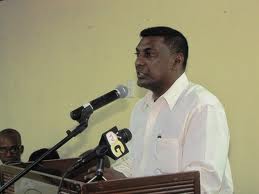Although all public health facilities ultimately fall under the purview of the Ministry of Health, the various Regional Administrations still have a responsibility to ensure that everything works.
This was the assertion of Chief Medical Officer (CMO), Dr Shamdeo Persaud, as he commented on concerns surrounding the West Demerara Regional Hospital (WDRH) which range from infrastructure to staffing challenges.
Even as he acknowledged that there is a great deal to be concerned about at the Region Three facility, Dr Persaud disclosed that the Ministry recognises infrastructure as a major challenge. He reflected on the fact, too, that it was an old sanatorium that was modified to serve as a general hospital and according to him, “there have been many problems and we are still trying to fix them at no little cost.” According to Dr Persaud, moves to address the operating room for instance represented a massive investment since it was done within a building that was not ideally designed for an operating room. As such, he noted that “always trying to retrofit something can be a bit more challenging than if you were to build a brand new facility and build it further at purpose…”
However, he noted that the facility has undergone extensive remodelling, particularly to the Accident and Emergency Unit and the Outpatient clinic.
Dr Persaud, who was offering his comments during an interview with this publication, disclosed that the vision for the WDRH is for it to offer a 24-hour service complete with emergency facilities and a dedicated doctor. The doctor, according to him, would be tasked with exclusively rendering service to the emergency unit with the capacity to assess and respond immediately to surgical needs as well as offer cardiac care and even be on hand to facilitate needful rapid transfers to the Georgetown Public Hospital Corporation (GPHC).
Already, the CMO said that the two facilities (WDRH and GPHC) are collaborating whereby their operations have been twinned, so much so that patients from the GPHC are transferred to the West Demerara hospital.
“What we have found is that bed occupancy, especially in the medical wards, are very low whereas at the GPHC patients were doubling up…the male medical ward, for example ,was actually utilising the surgical ward bed spaces,” said Dr Persaud.
“If people from over in that Region (Three) are attended to at the GPHC they (health officials) have now started to transfer them back over to the regional hospital where care can continue,” he added.
But even as infrastructural concerns are being addressed together with the accommodation of patients, Dr Persaud disclosed that nursing is another challenge at the facility that efforts are being made to address. He explained that because the nurse to patient ratio has been found to be very low, efforts were made to commence a programme that encourages nurses at various levels to offer additional service.
And this is certainly not a novel practice, as according to Dr Persaud, some nurses who work in the public sector are also know to render their service to private facilities as well. “We are saying that instead of going to the private hospitals we can give them that part-time employment right at the Government hospitals, and some of them have started even in Region Four at the GPHC,” Dr Persaud said.
Even midwives stationed in various districts are allowed to take shifts at the weekends and the evenings and according to Dr Persaud, “it is alright for them to do this once they have time, without compromising their usual duties… This is something that happens globally; people work more than one place adequately and are able to provide good quality service at both points of work,” said Dr Persaud. He noted too that “these are some of the things we are trying to do innovatively to address some of the shortages in terms of human resources.”
Meanwhile, efforts are also being made to address similar concerns at the Leonora Diagnostic Centre also in Region Three. Not so long ago the state of that facility was highlighted in the media following a visit by a Parliamentary Committee.
According to Dr Persaud, “I myself visited and saw Air Condition units dripping and the rooms were in conditions that are not conducive to good quality care…equipment was not working and these are a lot of administrative issues.”
The conditions prevail, Dr Persaud said, although an Administrator was appointed to manage the facility.
“We are at a loss as to why this has happened at a relatively small hospital that doesn’t have a high demand of service; it should be kept on par with the rest.”
As such, a newly appointed Regional Health Officer has been appointed in order to address the existing state of affairs through regular meetings and constant checks to ensure that the modus operandi is improved.
Also to be addressed is the delay in the completion of infrastructural work, since according to Dr Persaud, “what I have found from my own observation is that works are awarded and it takes an extraordinarily long time to even start much less complete.”
“They have contracts awarded and people are not delivering…the workers come and they look around and then they wait another couple of weeks then come back and do a little thing here and a little thing there. So there might be a little more need for active involvement by the management team in getting things going,” Dr Persaud said of the Diagnostic Centre.
- Home
- News
- Views
- Opinion
- Editorial
- Features
- Clinical
- Regions
- Anguilla
- Antigua and Barbuda
- Bahamas
- Barbados
- Belize
- Bermuda
- British Virgin Islands
- Cayman Islands
- Dominica
- Grenada
- Guyana
- Jamaica
- Montserrat
- Saint Kitts and Nevis
- Saint Lucia
- Saint Martin
- Saint Vincent and the Grenadines
- Saint-Barthélemy
- Trinidad and Tobago
- Turks and Caicos Islands
- US Virgin Islands














